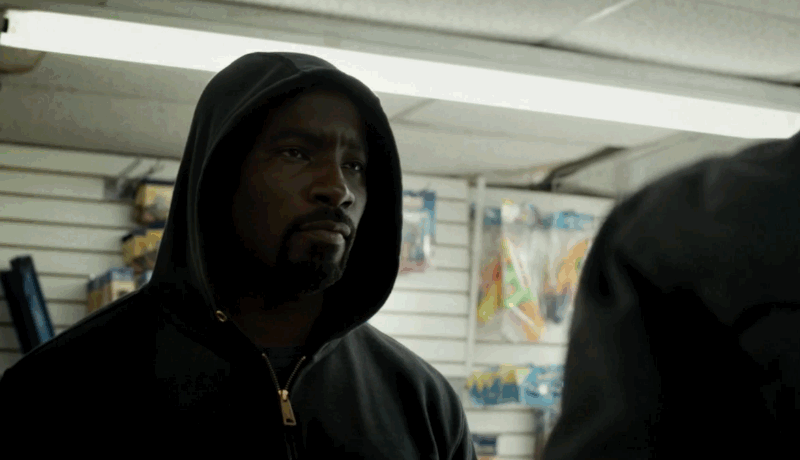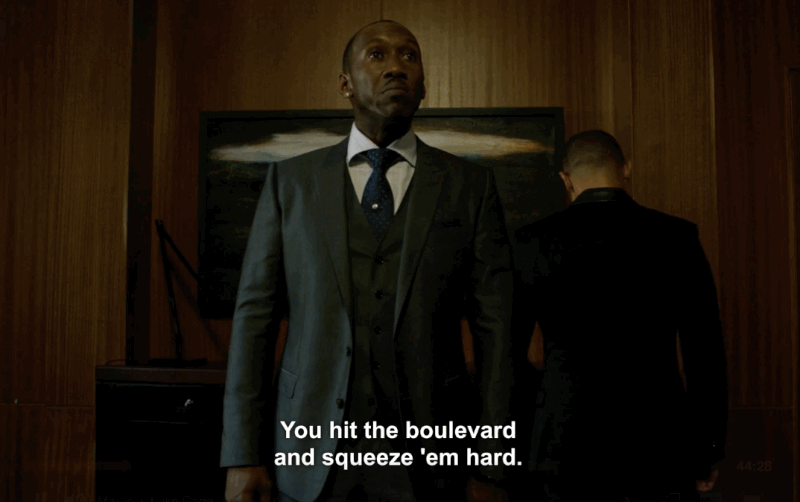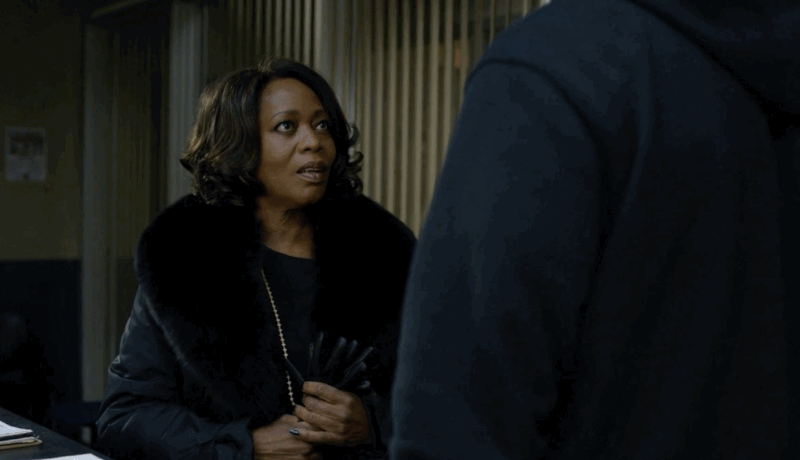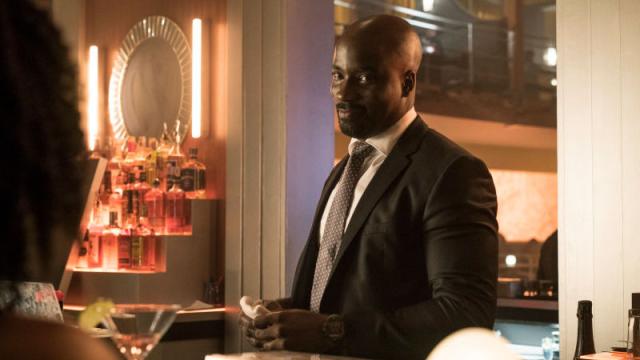For the most part, Luke Cage stands apart from most of the other Marvel superhero adaptations. Created and executive produced by Cheo Hodari Coker, it uses its setting and its main character as a conduit to a specific cultural history and a set of experiences, and that makes Luke Cage unique among all of Marvel’s live-action properties. It’s one of the series’ biggest strengths — and here’s what else we loved about the show, too.
Note: Seriously, if you have not watched all of Luke Cage yet, we suggest you stop reading now. Everyone else, let’s start breaking things down.

We Loved…
That Luke Cage Doesn’t Hate Himself

At the end of episode four, Luke Cage climbs out of crumbled remains of a building that gets destroyed after gun-running crimelord Cornell “Cottonmouth” Stokes fire a bazooka at him. When reporters run up to him and ask for his name, he thinks about it for a beat, pulls down his hood and says “My name is Luke Cage.” He’s not going to hide from the spotlight and what he has to do. He accepts what he’s become and the role he has to play.
While he does call himself a freak two episodes later, Luke doesn’t walk around with nearly as much inner turmoil as Matt Murdock or Jessica Jones. He’s got a complicated past that haunts him like those two characters, but he isn’t battling self-destructive behaviour. Sometimes he even seems to be having fun taking down bad guys. It’s a nice change from all the intense self-loathing Netflix’s other superhero shows have given us.
The Perfectly Tailored Fight Choreography

Luke Cage doesn’t really have a fighting style, which is perfect for a character with his powers. He just walks through people, never feeling a single blow, and casually takes them out with a toss or a punch. There was some concern about this when the previews were all we had to go on and some of the fight scenes looked awkward and uncool. But having watched the whole series, it makes a lot more sense. In most of his brawls, he’s playing a video game with invincibility on. There’s no challenge, and no reason to do anything flashy. And when he finally encounters something that can legitimately take him out, his victory feels like it happens because of guts and determination, not as a result of a cool martial arts style.
That Harlem Feels Like a Real Place

The main conceit of the Marvel approach to superheroes is that the stories set in the company’s fiction happen in the real world… or a relatively close approximation of it, anyway. The Hell’s Kitchen in Daredevil and Jessica Jones winds up feeling like a blank-slate AnyCity, USA, over the course of those shows, a backdrop where ninja mayhem occasionally happens. But, in Luke Cage, the neighbourhood matters in multiple ways. Harlem’s status as an epicentre for black history and culture is woven into the backstory of the show’s villains and the ongoing gentrification of the famous uptown enclave informs the political motivations of conniving councilwoman Mariah Dillard. It’s an area in the midst of fractious reconfiguration, ripe to be reimagined in someone’s vision.

And the fact that Luke Cage wasn’t from Harlem makes his heroism feel more altruistic. He didn’t have to be born in Harlem to decide to protect it. There was no sense of obligation and — thankfully — no moments where he runs around yelling about “my city.” His status as an outsider opens him to attacks by some of the very people he’s protecting and offers up a different sort of vulnerability for the bulletproof hero.
The Family Drama Felt Real

The villains and supporting characters on Luke Cage all came across as more nuanced than basically everyone other than Patsy Walker in Jessica Jones. The good guys, villains, regular folks alike — they felt like they existed before and after Luke Cage was on-screen. Family issues drive most of the drama in the show and do so in heartbreaking fashion. Even after she killed him in a fit of anger, it still feels like Mariah loves her cousin Cottonmouth. Whether it was the Stokes family’s status as Harlem’s alpha criminals, or Carl and Willis’ soured sibling relationship, viewers were getting a window on ongoing sagas that stretched back generations.
There’s some sharp recombination of major characters from Luke’s backstory, too. In the comics, former best friend Willis Stryker/Diamondback and Luke Cage’s brother James Lucas, Jr. were separate characters. Making them into one person only increases the animus between Cage and his archenemy. James Jr. underwent a similar procedure like to one that gave Cage his powers to fight his brother; the scene in the final episode with Dr. Noah Burstein visiting Willis in the hospital probably indicates that something similar will happen in season two.
How the Status Quo Shifted in a Big Way Halfway Through

Everything leading up to the release of Luke Cage framed Cornell Stokes as the primary antagonist for the show’s hero. And for seven episodes, Mahershala Ali wormed his way into our hearts as Cottonmouth strutted, screamed and brutalized his way through a collection of hypnotic scenes. Then he died, bludgeoned to death by his cousin Mariah. The most surprising thing about Cottonmouth’s exit isn’t that it happened; it’s that the creators had the confidence to take such a charismatic performance off the board, completely. But that cleared the decks for something even better…
There’s an Honest-to-Badness Supervillain Origin Story

The Marvel Netflix shows have excelled at delivering bad guys who feel three-dimensional, fleshed-out by impressive performances, strong writing, and believable motivations. When Wilson Fisk and Kilgrave appeared on Daredevil and Jessica Jones, they were fully formed and already committed to campaigns of corruption and terror. In Luke Cage, we watched Mariah Dillard slide down a slippery slope of morality, shedding the skin of a well-meaning but compromised politician to become Harlem’s new queenpin.
Alfre Woodard’s fantastic turn as Mariah offers up multiple facets of a middle-aged woman. One minute, she’s a career politician, an election-winning auntie who proffers platitudes she doesn’t necessarily believe. The next, she’s scheming and spinning incriminating circumstances into a sympathetic narrative for herself. Mariah’s struggle and transformation is by far the best part of season one’s back half.
How It’s Not the Same Old Central Casting

There’s a great scene in episode eight where Inspector Ridley, Misty Knight, and Claire Temple are all reckoning with each other, and another in episode 13 where Misty, her boss and Mariah have a tense moment, where each woman represents different vectors of power, morality, and duty clashing with each other. It’s the kind of moment where all the characters would have been played by white guys in a different time or series. One of Luke Cage‘s big wins is in having women of colour play roles like these.
But We Didn’t Like…
The Lame-Arse Super-Science

The prison experiments that give Luke his steel-hard skin and super-strength are the worst kind of genre convention. They just exist to turn him into “Power Man” and aren’t grounded in the logic or the tone of the show. We get some vague explanation about the military and/or medical applications of Dr. Burstein’s prison experiments, but it all comes across as hard-to-swallow faux science instead of entertaining mad science, like if a regular MRI machine turned Bruce Banner into the Hulk.
How This Version of Luke Cage Is a Lot More Square

In his various comics series, Luke Cage is a hot-tempered loudmouth from the streets. He explodes into action and talks a lot of trash when fighting crime. The Netflix iteration of the character comes from a middle-class background and suffers his drama in silence. That shift in tone locks lead actor Mike Colter into a glum mode that falls flat compared to some of the more energetic or modulated performances of his co-stars. Hopefully, he gets more fun stuff to do in The Defenders.
